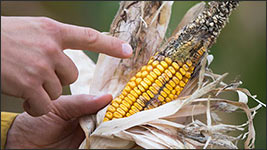
Aspergillus ear rot has been apparent in some Kansas corn this year, especially in hot, humid but dry conditions. The fungus sometimes signals the development of aflatoxin, a carcinogen.
Watch for Signs of Aflatoxin in Drought-stressed Corn
Aspergillus ear rot is being found in Kansas at the highest levels in five years.
When it comes to the weather in Kansas this year, the state is again one of the haves and the have-nots. Parts of Kansas have had more-than-normal precipitation while others, mostly in the central part of the state, are in abnormally dry to moderate drought conditions.
It is those hot, humid and drought-like conditions where aflatoxin is typically found in corn, said Doug Jardine, plant pathologist with Kansas State University (K-State) Research and Extension. He’s encouraging farmers to be on the lookout for signs that it could be present.
Aflatoxin, a poisonous carcinogen, is a naturally occurring toxin caused by the fungus Aspergillus flavus, a greenish-yellow, dime- to quarter-sized mold that grows on corn ears between the kernels. In severe cases, the mold may cover larger portions of the ear.
Jardine said he’s had no reports of positive samples of aflatoxin in corn from elevators to date, but he and others have found Aspergillus ear rot at levels not seen since 2012. The simple presence of the fungus can, but does not necessarily, translate to aflatoxin problems because different field strains of the fungus can be more or less efficient at producing the toxin.
The U.S. Food and Drug Administration (FDA) has established 20 parts per billion (ppb) or higher as the level at which aflatoxin is deemed unsafe for human consumption, and many buyers of corn for human or pet consumption have more stringent standards, Jardine said.
Most grain elevators now use a test that can be performed quickly at the point of delivery, rather than the outdated black-light method, he said. Samples of corn that test at less than 100 ppb are usually accepted without penalty. Levels over 100 ppb may be docked a percentage or not accepted at all.
Jardine shared other facts about aflatoxin:
- Ethanol plants may also refuse aflatoxin-contaminated grain because the toxin is heat stable and can concentrate as much as three- to fourfold in distillers’ grains that are fed to livestock.
- Aflatoxin-contaminated corn at any level should not be fed to lactating dairy cows because it can be passed through to the milk.
- At 20 ppb-100 ppb, corn can still be fed to breeding cattle, swine and mature poultry. Grain testing at 100 ppb-200 ppb can be used for swine weighing more than 100 pounds (lb.) and for beef cattle. Corn with aflatoxin levels from 200 ppb to 300 ppb can only be used for finishing beef cattle.
- Grain with aflatoxin levels higher than 300 ppb cannot be used as feed unless it has been cleaned or blended with enough non-contaminated grain to reach safe levels. Blended corn cannot be moved off-farm without a specific exemption from the FDA. An exemption was granted to several states, including Kansas in 2012. It is too early to know if another exemption will be needed this year.
- Drought-stressed corn harvested for silage may also contain aflatoxin.

Editor’s Note: Mary Lou Peter is a communications specialist, news writer and editor with the K-State Research and Extension News Media Services Unit.






